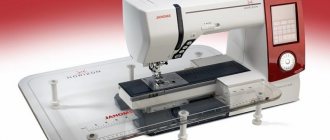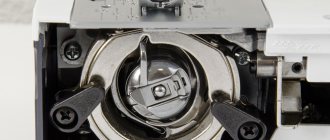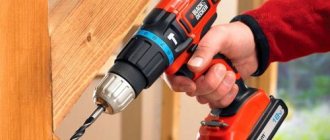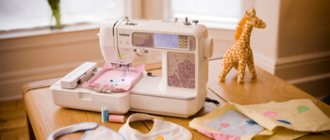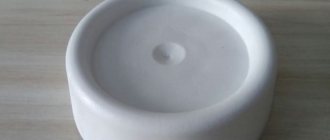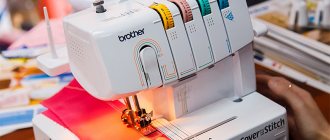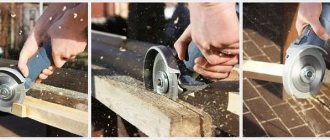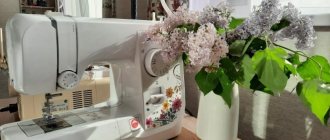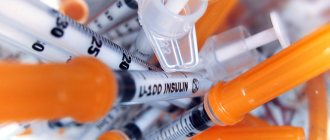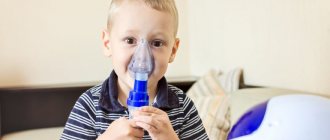How to choose a sewing needle? This question is asked by everyone who starts sewing. A needle is one of the most important components of the sewing process and a lot depends on its correct choice! Once you start working with the wrong needle, problems will not keep you waiting: from torn threads to a broken sewing machine. We'll tell you how to choose a sewing needle depending on the project you're doing and the fabric you've chosen for it. In order to navigate the assortment of needles offered by stores, you do not need to have knowledge of the technical intricacies of production. It is enough to understand the marking methods and know what the parts of the needle are called. After a short theoretical part, we will help you choose a needle for any occasion!
Main parts of machine needle
- The bulb is the thick upper part of the needle that is fixed in the sewing machine. The flask of industrial needles is completely round, while the flask of household needles is flat on one side.
- The blade (shaft) of the needle is the main narrow part; it is its diameter that becomes the size of the needle.
- Eyelet is the hole into which the thread is threaded.
- Groove (groove) is a notch along the front of the needle, from the bulb to the eye.
- The point is the tapering part from the eye to the tip of the needle
- The tip is the end of the needle and comes in different shapes depending on the type of needle.
Hand Needles Hand needles are simpler and consist of an eye, a shaft, a point and a tip.
Overlock needles Overlock needles have the same parts as regular machine needles, but are made slightly differently and cannot replace each other.
Defects in sewing needles cannot be corrected.
Before installing the needle, you need to check whether it is bent, dull or rusty. There are other defects, for example, the absence of an eye or its incorrect location in relation to the thread groove, but this is quite rare.
defective sewing needles , including bent and blunt ones, so that they do not come to hand. Never attempt to sharpen or straighten a sewing needle. Any needle defect of this type cannot be corrected. Sewing needles, especially sewing machine needles, are made of especially strong steel, and a good needle is one that breaks when hit or tried to straighten it, rather than bending like a nail.
Needle marking
Hand needles are produced without special markings. Their name reflects their functions: universal sewing, embroidery, darning, for leather, for beads, etc. Also on the packaging is the needle size: from 1 to 15 or 13-26 (different systems). The sewing machine needle is marked with a special code that will help you find the right needle even without packaging. This code consists of numbers and letters and is located on the flask. The numbers are the diameter (thickness) of the needle, measured in hundredths of a millimeter or fractions of an inch. For example, the number 60 corresponds to a thickness of 0.6 mm. Sometimes the manufacturer indicates both sizes, then the values are written as 80/12. The letters will tell you which machines and materials this needle should work with. The letter H stands for a universal needle; its tip is slightly rounded. Clarifications regarding the type of fabric are added with a hyphen.
Marking options
Recently, color designations for needles have been used: blue bulbs for denim needles, crimson bulbs for microtex needles, yellow bulbs for knitwear needles.
Types of needles for sewing machines
Residents of Moscow and St. Petersburg can easily choose the right tool - variety allows. If you live in a small town, online shopping will be your salvation. They can order parts of all sizes and shapes for any sewing machine. There is no need to worry about delivery by mail, because this is a group of goods that is difficult to damage. The cost of quality products is affordable, and if you are serious about sewing, you should not skimp on tools - a bad needle can seriously damage the fabric. Which manufacturers have become the favorites of professionals?
For knitwear
The tool should not cut the fabric, so it is advisable to choose samples with a round tip. The part does not pierce the threads, but passes between them. The best options for knitwear: HS, H-SUK, H-SES. Popular model:
- Name: SCHMETZ Stretch 130/705 HS.
- Price: 125 rubles.
- Characteristics: set of 5 copies – 2×65, 2×75, 1×90. Material of manufacture: nickel. The flask is cut, diameter 2.04 mm.
- Pros: excellent product quality, suitable for highly elastic knitted materials, standard bulb size for household sewing machines.
- Cons: none found.
The German company Schmetz is a leader in the production of goods in this category. Sewing needles for machines from this manufacturer break extremely rarely. Product ideal for knitwear:
- Name: SCHMETZ Jersey 130/705 H-SUK Combi.
- Price: 89 rub.
- Characteristics: set contains 5 needles – 1×70, 2×80, 1×90, 1×100. Made of nickel, steel color. The flask is cut, diameter 2.04 mm.
- Pros: Best choice for knitwear.
- Cons: none found.
For skin
Another titan in the production of needles for various purposes is the Japanese company ORGAN NEEDLE co. Ltd. Experienced seamstresses know that the Lady and the Organ emblem is a symbol of reliability. For dense materials, craftswomen use the following model:
- Name: Machine leather needle Organ Needles Leder Leather Cuir130/705 H-LL.
- Price: 270 rub.
- Characteristics: set contains 5 samples – 3x90, 2x100. Suitable for working with suede, pigskin, calfskin, goatskin.
- Pros: long service life, excellent stitch quality.
- Cons: there are factory defects with defective ears, there are many fakes on sale.
Another German company produces quality products. The Groz-Beckert brand (the name Grotz-Beckert is often found on the Internet) specializes in the creation of industrial needles. For leather the company has the following set:
- Name: Groz-Beckert DBx1 LR.
- Price: 190 rub.
- Characteristics: set includes 10 copies No. 90/14. The length from the beginning of the needle eye to the base is 33.8 mm. The thickness of the flask is 1.62 mm. The product is intended for upright machines, creates a diagonal seam with a slope to the right.
- Pros: low rate of breakage, thread breakage, stitch skipping, high cut quality, long service life.
- Cons: not suitable for home sewing machines.
For denim
The very sharp end of the HJ type piece fits neatly into thick fabric without damaging the threads. The needlewomen liked this set of tools:
- Name: Prym Nadeln Jeans 130/705.
- Price: 271 rub.
- Characteristics: set includes 5 samples No. 90/14. Material of manufacture – steel, color – silver. The smoothing size corresponds to the needle size.
- Pros: the eyelet is well polished, which prevents damage to the thread, the parameters of the part ensure ideal loop formation and error-free threading.
- Cons: expensive.
There are needles on sale from domestic manufacturers. They are cheap, so needlewomen for whom sewing is a rare hobby buy them. Budget proposal:
- Name: Needle for Artie jeans.
- Price: 42 rub.
- Characteristics: set includes 5 samples No. 100. Manufacturing material – tool steel.
- Pros: inexpensive, works well.
- Cons: often break and bend.
For finishing stitch
Using a double or triple needle you can make beautiful finishing seams. The H-ZWI, H-DRI tool is not suitable for all machines, but only for those with a zigzag stitch (Singer, Brother, Janome, Juki and others), and it works exclusively in straight stitch mode. The following model is popular:
- Name: Double needles for Hemline knitwear.
- Price: 189 rub.
- Characteristics: the set contains one copy No. 80, the distance between the rods is 4 mm. Manufacturing material – steel. Suitable for creating decorative stitching on knitted, elastic fabric with thick pile. The tip is rounded.
- Pros: durable, does not damage fibers, suitable for all modern machines.
- Disadvantages: does not always make the perfect line, is whimsical in work.
Particularly beautiful stitches are obtained when using a triple needle. To make a decorative seam perfect, you need to choose a high-quality tool, for example:
- Name: SCHMETZ Universal Triple Needle H-DRI.
- Price: 169 rub.
- Characteristics: the set contains one universal specimen No. 80 with a distance between the rods of 2.5 mm. Material of manufacture: nickel.
- Pros: convenient plastic case for storage and carrying, high durability of the product.
- Cons: none found.
Double needle
A tool with two rods is designed for making decorative seams that do not experience heavy loads. If you need to embroider parallel elements of a design at the same time, a double needle is indispensable. Popular Tool:
- Name: Hemline Klasse double embroidery.
- Price: 151 rub.
- Characteristics: one copy No. 75 with a distance between the rods of 3 mm. Product length – 3.8 cm. Color: steel, red. Purpose: finishing with stitching after embroidering with polyester or rayon threads on thin fabrics.
- Pros: a large hole into which the thread can be easily threaded; it is convenient to store the product in a plastic case.
- Cons: requires reduced speed in operation.
- Removal of a polyp of the cervical canal: operations
- Allergy medications for children and adults
- Floristry for beginners - step by step assembly of bouquets. Fundamentals and styles of floristry for composing compositions
Sales on this part are rare because the price is affordable. The price category of the following manufacturer is higher than that of other well-known brands, but the quality is consistent:
- Name: Prym Double Needle 130/705.
- Price: 271 rub.
- Characteristics: one copy No. 100, width between rods 6 mm. The point is rounded, intended for knitwear.
- Pros: durable, long lasting.
- Cons: none found.
With wings
Using a sword-shaped needle, you can create beautiful openwork stitches and hemstitching. Top seller in category:
- Name: SCHMETZ Hemstitch Needle 130/705 H WING.
- Price: 180 rub.
- Characteristics: the set contains one copy No. 100/16 with two longitudinal projections (wings) on the rod. Used on loosely woven materials.
- Pros: The sewing machine needle is of impeccable quality.
- Cons: none found.
A tool with wings creates an openwork pattern that looks especially impressive on fabrics with a loose weave structure: cambric, linen, cotton. Popular Product:
- Name: Hemline Klasse for hemstitching.
- Price: 215 rub.
- Characteristics: the set contains one copy No. 100/16. Product length – 3.9 cm.
- Pros: lasts a long time, durable, does not bend.
- Cons: expensive.
Self-threading needle
The tool is convenient for those who find it difficult to thread a needle. At the same level as the eyelet there is a slot through which the thread is passed, after which it enters the eyelet itself. The model is optimal for working with medium-weight fabrics. Self-threading needles for sewing machines are extremely rare on sale; there are no such sets in the lines of well-known manufacturers. If a person has difficulty threading, you can use the following tool:
- Name: Threader for Hemline 136 sewing machine.
- Price: 218 rub.
- Characteristics: the set includes two threaders - a needle threader (extra-long for overlockers and sewing machines), a loop threader (thin threader for overlockers).
- Pros: makes it easier to insert the thread into the eye.
- Cons: It is not clear from the manufacturer’s description how to use the device.
Manufacturing companies
In sewing supply stores you will find a large selection of needles from different companies. What sewing needles are best to buy? We advise you to choose needles from trusted manufacturers: the German companies Schmetz and Grotz-Beckert, as well as the Japanese company Organ Needles. The products of these companies justify their price with a wide range and excellent quality, especially for special needles (knitwear, stretch, etc.). Universal economy class needles are produced by the Russian group and the Australian company Hemline.
The curator of the supply of Schmetz needles in the Russian Federation, Elmar Brandt, explained that all Schmetz needles are made from the same wire. Then, depending on the type, the needles are plated with nickel or chromium.
Compatibility table for sewing needles and fabrics
| Material | Textile | Needle size | Needle marking |
| Textile | Lightweight (material for shirts, blouses) | 60-70 | H, H.M. |
| Medium (costume material) | 80-90 | H,H.J. | |
| Heavy (coat material) | 100-110 | H,H.J. | |
| Denim | Lightweight | 70-90 | H,H.J. |
| Average | 100-110 | H.J. | |
| Densely woven materials | Lightweight (microphase, silk, taffeta) | 60-80 | H.M. |
| Medium (twill, canvas) | 100-110 | H.J. | |
| Knitwear | Thin | 60 | H,HS |
| Average | 70-80 | H-SUK | |
| Rude | 80-90 | H-SUK | |
| Highly elastic knitted or kid fabric | Thin | 65-70 | H.S. |
| Average | 80-90 | H.S. |
Choose your sewing needle wisely - it must match the type of fabric and thread being processed.
There should be one needle per product - this is the law observed by professional seamstresses. Never skimp on this sewing tool - this will allow you to always achieve only the best results in your work.
The needle is the most important element of a sewing machine, on which the quality of sewing essentially depends. Needles can have different sizes of the ear hole and groove, different variations in tip sharpening and other nuances that must be taken into account when processing different types of fabrics.
So, how can you choose this sewing element correctly so that the stitching comes out of the highest quality, and the final result exceeds all expectations?
Sewing needles
Now let's find out how to choose a sewing needle. We will focus on the type of material you will use in your work.
Universal needle
Denim needle
Needle for tightly woven materials (microtex)
Knitting needle
Needle for stretch materials
Select by device type
When purchasing, it is recommended to take the following criteria as a guide:
- Manufacturer. Here are just some of the companies that have become the best - Groz-Beckert, Organ, Scnmertz. If you give preference to well-known companies, you don’t have to worry about quality. The curvature of the tool and the absence of external defects are the most important parameters checked before starting work.
- Characteristics of the fabric, the use of which is planned. There are special tables containing information regarding the purpose of each type of instrument. Different fabrics require their own shapes and thickness.
- A type of sewing machine. For example, an industrial look. It is better to study the instructions issued for the device in advance. This document also provides recommendations on which tool is best to take in a given case. When replacing, it is especially important to observe this point; serious differences are noticeable in the flasks.
You may be interested in this Instructions for sewing bandalettes with your own hands
Needle selection
How to choose the right needles for your home sewing machine?
The needles of home devices are equipped with flat flasks. This makes the correct installation of tools and other accessories easier. Industrial needles should not be used inside household appliances. If a curvature is detected, you can try to straighten it to correct the defect. You need to choose the right tool.
Important. If the quality of the products is high, they will not bend. Steel or nickel will simply break if you try too hard to fix the situation. But this is an indicator that the device is of high quality.
Exploitation
For hand embroidery
For hand cross stitch, use short needles, up to 3 cm long. They have a rounded point that gently pushes the fabric weave apart, and an elongated oval-shaped eye into which it is convenient to insert floss threads in several layers. These needles are also called tapestry needles and have sizes from 13 to 28. For embroidery with satin or artistic satin stitch, you should take longer and sharper needles. For embroidery, you can also use a special double-sided needle.
It is longer than regular needles and has a hole in the middle for thread. A double-ended needle is designed to allow you to embroider with both hands without turning the needle, which significantly saves time. When working with beads, take the thinnest needles with the same thin eye. This needle will easily fit into the thin hole of the bead.
For machine embroidery, use special needles!
How to use a needle
After checking on the scrap piece that the needle is threaded in the correct way and that the stitching is coming out well, you can begin to work. To make the seams beautiful and neat, you need to adhere to some rules for using a needle:
- before starting, slide the product under the foot, lower the needle so that it pierces the fabric, then place the foot and sew;
- be sure to bring the ends of the threads no shorter than 8-10 cm behind the foot;
- the working part of the product must be laid out to the left of the needle, and the allowances must go along the right side, then the stitching will have a neat appearance;
- during work, constantly monitor the thread tension and monitor the stitch parameters;
- If the fabric slips off the teeth during sewing, stop working immediately;
- Upon completion of the stitching, the needle and presser foot must be raised, the stitched part removed from the teeth, and the threads cut with a special knife on the sleeve of the machine.
For machine embroidery
They are made more durable to cope with increased impact loads.
And, although the price of such needles is significantly higher, the service life of an embroidery needle is much longer. Most often, 75/11 needles are used for embroidery; 90/14 needles are suitable for working on thick fabrics. Embroidery needles are distinguished by red bulbs and the following letter codes
How to check the curvature of a sewing needle
It is difficult to visually determine whether the needle is straight or bent. Use this method (see picture) to check the curvature of the needle. Such a test may be useful to you if you cannot find the cause of skipped stitches on your sewing machine or overlocker. Sometimes it happens that the nose of the shuttle or the looper of the overlocker gets into the needle itself. The needle bends slightly, but in appearance it is absolutely straight. This results in skipped stitches in the stitching. Always start searching for the cause of gaps by checking the needle.
The curvature of the sewing needle is checked against a dark background by quickly scrolling. If the point of the needle remains at one point, then it is straight. A dull needle can be identified by running the nail of your right thumb along the tip of the needle. The nail will definitely reveal a bent place on the tip. Never use sewing needles with rust. They will ruin the fabric, especially thin and delicate fabric, and hold the thread as it moves along the needle.
Working with leather and fur
Skin needles are produced with an unusual tip shape. It looks like a spatula, has a beveled edge and a triangular sharpening. Hand needle leather needle size from 1 to 8. Machine leather needles are marked
They pierce the material at an angle of 45 or 135 degrees to the seam line itself, thus creating a beautiful inclination of the stitches (to the right or to the left). Sizes from 90/14 to 110/18. To hand stitch fur, use the same needles as for leather. A machine for stitching natural fur is called a furrier machine. Choose needles for such a machine following the instructions; unlike ordinary needles, they are not universal. For thinner fur, such as mink, needles of size 40-60 are suitable, for thick sheepskin - size 80.
Drawing conclusions
Useful tips
What needle size to install in a sewing machine depends on the thickness of the layer of working material. It may not be possible to immediately determine the type of needle. The required size should be determined experimentally on a fabric sample.
Expert opinion
Maria Anishchenko
Experienced seamstress, total experience 18 years
The needle is not durable and requires constant attention. For high-quality sewing, it is recommended to change it every 15 hours of continuous operation. In everyday work, experienced seamstresses change the needle after one cycle (finished item), especially when using thick fabrics or leather.
For a beginner, it is advisable to purchase sets of different types of needles and try them on several types of fabric. This will give you the opportunity to get used to the sewing machine and experience the working process yourself.
New needles may be defective. Before installation, it would be a good idea to conduct a visual inspection of the product.
Letter designations
Each marking indicates the type of tool suitable for working with a particular fabric. The following types of needles exist.
- N is a type of needle suitable for all types of work; professionals call them universal. The color blue is used to denote it. These needles are convenient to work with dense matter, as they have a very sharp sharpening. Works great when making jeans or canvas items, even on Brother home machines;
- N-M – microtex needles, marked with purple paint. They are distinguished by their thinness and sharpness of sharpening. Designed to work with the finest fabrics such as silk, fleur and taffeta. The shape of sewing machine needles allows you to carefully process delicate fabrics without destroying their structure.
- H-S – needles for household sewing machines, used when working with elastic fabrics. They are usually marked with yellow paint. This type of needle is characterized by its rounded tip. This needle is especially popular when working with knitwear or stretchable synthetics. The special shape of the edge reduces the likelihood of gaps in the stitching.
- N-E – needles for embroidery, which are painted red. They have a noticeably rounded eye and an edge designed for fine work. Similar needles are used for industrial sewing machines, such as jamone, and for home appliances.
- H-Q is a needle used for quilting. The special structure of the point with a bevel allows such a needle to work without any traces of holes on the fabric.
- N-SUK is an instrument with an almost blunt round ear. Used for knitted products. For example, it is very convenient for her to process knitwear, jersey, and hand-knitted clothes.
- N-LR – needle for leather. To work with such dense material, the needle point is sharpened at an angle of forty-five degrees. The cutting edge allows you to create decorative stitches and slightly angled stitches. It is not recommended to use this tool on other types of fabric.
